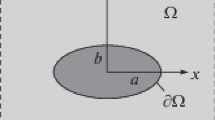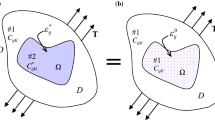Abstract
The Eshelby tensor for a plane strain inclusion of arbitrary cross-sectional shape is first presented in a general form, which has 15 independent non-zero components (as opposed to 36 such components for a three-dimensional inclusion of arbitrary shape). It is based on a simplified strain gradient elasticity theory that involves one material length scale parameter. The Eshelby tensor for an infinitely long cylindrical inclusion is then derived using the general form, with its components obtained in explicit (closed-form) expressions for the two regions inside and outside the inclusion for the first time based on a higher-order elasticity theory. This Eshelby tensor is separated into a classical part and a gradient part. The latter depends on the position, the inclusion size, the length scale parameter, and Poisson’s ratio. As a result, the new Eshelby tensor is non-uniform even inside the cylindrical inclusion and captures the size effect. When the strain gradient effect is not considered, the gradient part vanishes and the newly obtained Eshelby tensor reduces to its counterpart based on classical elasticity. The numerical results quantitatively show that the components of the new Eshelby tensor vary with the position, the inclusion size, and the material length scale parameter, unlike their classical elasticity-based counterparts. When the inclusion radius is comparable to the material length scale parameter, it is found that the gradient part is too large to be ignored. In view of the need for homogenization analyses of fiber-reinforced composites, the volume average of the newly derived Eshelby tensor over the cylindrical inclusion is obtained in a closed form. The components of the average Eshelby tensor are observed to depend on the inclusion size: the smaller the inclusion radius, the smaller the components. However, as the inclusion size becomes sufficiently large, these components are seen to approach from below the values of their classical elasticity-based counterparts.
Similar content being viewed by others
References
Eshelby J.D.: The determination of the elastic field of an ellipsoidal inclusion, and related problems. Proc. R. Soc. Lond. A241, 376–396 (1957)
Eshelby J.D.: The elastic field outside an ellipsoidal inclusion. Proc. R. Soc. Lond. A252, 561–569 (1959)
Mura T.: Micromechanics of Defects in Solids, 2nd edn. Martinus Nijhoff, Dordrecht (1987)
Li S., Wang G.: Introduction to Micromechanics and Nanomechanics. World Scientific, Singapore (2008)
Mori T., Tanaka K.: Average stress in matrix and average elastic energy of materials with misfitting inclusions. Acta Metall. 21, 571–574 (1973)
Weng G.J.: The theoretical connection between Mori-Tanaka’s theory and the Hashin-Shtrikman-Walpole bounds. Int. J. Eng. Sci. 28, 1111–1120 (1990)
Li S., Wang G., Sauer R.A.: The Eshelby tensors in a finite spherical domain—Part II: applications to homogenization. ASME J. Appl. Mech. 74, 784–797 (2007)
Hill R.: A self-consistent mechanics of composites materials. J. Mech. Phys. Solids 13, 213–222 (1965)
Budiansky B.: On the elastic moduli of some heterogeneous materials. J. Mech. Phys. Solids 13, 223–227 (1965)
Huang Y., Hu K.X., Wei X., Chandra A.: A generalized self-consistent mechanics method for composite materials with multiphase inclusions. J. Mech. Phys. Solids 42, 491–504 (1994)
Le Quang H., He Q.-C.: A one-parameter generalized self-consistent model for isotropic multiphase composites. Int. J. Solids Struct. 44, 6805–6825 (2007)
Marcadon V., Herve E., Zaoui A.: Micromechanical modeling of packing and size effects in particulate composites. Int. J. Solids Struct. 44, 8213–8228 (2007)
Vollenberg P.H.T., Heikens D.: Particle size dependence of the Young’s modulus of filled polymers: 1. Preliminary experiments. Polymer 30, 1656–1662 (1989)
Vollenberg P.H.T., de Haan J.W., van de Ven L.J.M., Heikens D.: Particle size dependence of the Young’s modulus of filled polymers: 2. Annealing and solid-state nuclear magnetic resonance experiments. Polymer 30, 1663–1668 (1989)
Reynaud E., Jouen T., Gauthier C., Vigier G., Varlet J.: Nanofillers in polymeric matrix: a study on silica reinforced PA6. Polymer 42, 8759–8768 (2001)
Cho J., Joshi M.S., Sun C.T.: Effect of inclusion size on mechanical properties of polymeric composites with micro and nano particles. Compos. Sci. Tech. 66, 1941–1952 (2006)
Nikolov S., Han C.-S., Raabe D.: On the origin of size effects in small-strain elasticity of solid polymers. Int. J. Solids Struct. 44, 1582–1592 (2007)
Cheng Z.-Q., He L.-H.: Micropolar elastic fields due to a spherical inclusion. Int. J. Eng. Sci. 33, 389–397 (1995)
Cheng Z.-Q., He L.-H.: Micropolar elastic fields due to a circular cylindrical inclusion. Int. J. Eng. Sci. 35, 659–668 (1997)
Ma H.S., Hu G.K.: Eshelby tensors for an ellipsoidal inclusion in a micropolar material. Int. J. Eng. Sci. 44, 595–605 (2006)
Liu X.N., Hu G.K.: Inclusion problem of microstretch continuum. Int. J. Eng. Sci. 42, 849–860 (2004)
Kiris A., Inan E.: Eshelby tensors for a spherical inclusion in microstretch elastic fields. Int. J. Solids Struct. 43, 4720–4738 (2006)
Ma H.S., Hu G.K.: Eshelby tensors for an ellipsoidal inclusion in a microstretch material. Int. J. Solids Struct. 44, 3049–3061 (2007)
Zheng Q.-S., Zhao Z.-H.: Green’s function and Eshelby’s fields in couple-stress elasticity. Int. J. Multiscale Comput. Eng. 2, 15–27 (2004)
Gao, X.-L., Ma, H.M.: Green’s function and Eshelby’s tensor based on a simplified strain gradient elasticity theory. Acta Mech. (in press) (2008). doi:10.1007/s00707-008-0109-4
Lakes R.: Experimental methods for study of Cosserat elastic solids and other generalized elastic continua. In: Muhlhaus, H. (eds) Continuum Models for Materials with Micro-Structure, pp. 1–22. Wiley, New York (1995)
Lam D.C.C., Yang F., Chong A.C.M., Wang J., Tong P.: Experiments and theory in strain gradient elasticity. J. Mech. Phys. Solids 51, 1477–1508 (2003)
Luo H.A., Weng G.J.: On Eshelby’s S-tensor in a three-phase cylindrically concentric solid, and the elastic moduli of fiber-reinforced composites. Mech. Mater. 8, 77–88 (1989)
Gao X.-L., Park S.K.: Variational formulation of a simplified strain gradient elasticity theory and its application to a pressurized thick-walled cylinder problem. Int. J. Solids Struct. 44, 7486–7499 (2007)
Ashby M.F.: The deformation of plastically non-homogeneous materials. Phil. Mag. 21, 399–424 (1970)
Fleck N.A., Muller G.M., Ashby M.F., Hutchinson J.W.: Strain gradient plasticity: theory and experiment. Acta Metall. Mater. 42, 475–487 (1994)
Arfken G.B., Weber H.-J.: Mathematical Methods for Physicists, 6th edn. Elsevier, San Diego (2005)
Xun F., Hu G.K., Huang Z.P.: Effective in plane moduli of composites with a micropolar matrix and coated fibers. Int. J. Solids Struct. 41, 247–265 (2004)
Gradshteyn I.S., Ryzhik I.M.: In: Jeffrey, A., Zwillinger, D. (eds.) Table of Integrals, Series, and Products, 7th edn. Academic Press, Boston (2007)
Magnus W., Oberhettinger F., Soni R.P.: Formulas and Theorems for the Special Functions of Mathematical Physics. Springer-Verlag, New York (1966)
Author information
Authors and Affiliations
Corresponding author
Rights and permissions
About this article
Cite this article
Ma, H.M., Gao, X.L. Eshelby’s tensors for plane strain and cylindrical inclusions based on a simplified strain gradient elasticity theory. Acta Mech 211, 115–129 (2010). https://doi.org/10.1007/s00707-009-0221-0
Received:
Revised:
Published:
Issue Date:
DOI: https://doi.org/10.1007/s00707-009-0221-0




